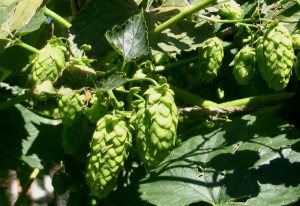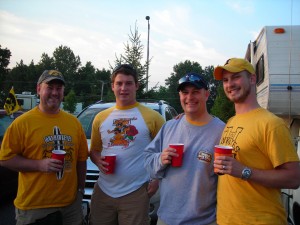This day in history: in 1933, President Franklin D. Roosevelt repealed the Volstead Act (Prohibition), legalizing 3.2% ABW (4% ABV) beer, ending the “Noble Experiment”. This makes today “National Beer Day”, so raise your glass and celebrate!
Category: Homebrewing
In case you want make your own beer at home
What is Dry-Hopping?

If you’ve been trying beer for a while, you may have heard the term “dry-hopping”, but what is dry-hopping, and how does it affect your beer?
Let’s discuss hops. In the beginning of beer, hops were not the primary bittering agent or preservative. Instead, other ingredients were used, including a mixture of herbs called gruit that was regulated by rulers, and was taxed heavily.
After some time of being excessively taxed, brewers began to look for other additives that would allow them to preserve and balance the beer without the excessive taxation of gruit. That’s when hops were discovered for use in beer. Initially, they were added mainly as a preservative, and were used in styles such as Pale Ales and India Pale Ales. Also, at the same time, beer drinkers began to like the hop flavor and aroma, and brewers began to use hops exclusively, and even began adding hops during other parts of the brewing process to enhance the flavor and aroma.
Fast forward about a hundred years, when beer-lovers in America started enjoying these hop-accentuated styles. After some time, we loved the flavor and aroma of hops so much, we expanded the use in hops even further.
Normally, hops are used in the brewing process during the boiling of the liquid, also known as wort (pronounced wert), to balance the flavor, so the finished beer is not overly sweet. After the wort has been boiled, it is cooled, and the yeast is added to convert the wort into beer.
The idea of dry-hopping is to enhance the hop flavor and aroma of the finished beer. Because the oils in the hop cone are volatile, the aroma tends to boil off during the boiling of the wort, and escape from the fermentation vessel when carbon dioxide is created and released. By the time the beer is finished, there is still some aroma left, but to enhance this, brewers add hops to the finished beer. This allows the hop oils to saturate the beer, and improve the finished hop aroma and flavor.
What types of beer styles are usually dry-hopped? As just mentioned, Pale Ales and India Pale Ales are the usual suspects, but any time the brewer wants to enhance the hop flavor and aroma, dry-hopping is used. Some of my favorites include Saisons and a few Irish Red Ales .
Personally, I recently created an IPA, and dry-hopped using Simcoe hops. It ended up being my most hop fragrant home-brewed beer to date, and I can’t say enough great things about dry-hopping!
So, the next time you see that a certain beer is “dry-hopped”, you now know that you should expect to have a great flowery/citrusy/floral hop aroma and flavor to enhance your beer.
Now that you are an expert on dry-hopping, what’s your favorite dry-hopped beer?
Midwest Supplies is Having a Sale!
My favorite homebrew supply store, Midwest Supplies, moved to their new location today, and are having a move-in sale this Wednesday, March 24, 2010. All in-stock items will be 10% off for online orders. Time to stock up on brewing supplies!
Tailgating with Homebrew

Since becoming homebrewers almost two years ago, my friends and I have found every reason to have home-made beer at events. Get-togethers, parties, you name it, and we would have homebrew.
This never was more true than this past Iowa Hawkeyes football season. At the beginning of the season, two of my friends and I decided to create and keg a 5 gallon batch for every Hawkeye home game instead of the regular old tailgate beer (yuck).
There were seven home games, so we decided to split it up that I would brew three batches, and my two friends would each brew two.
We already knew how to make the beer, and we had the 5 gallon soda kegs, so all we needed were the “extras” to make it perfect. We used our carbon dioxide tanks and regulators to push the beer, and we purchased a picnic-style tap to dispense the beer. To make the beer stay cold, we bought a “Keglove“, which is a neoprene sleeve that houses an ice blanket. This sleeve fit over the soda keg, and kept the beer cold for several hours.
Because the University of Iowa doesn’t allow kegs, even 5 gallon kegs for responsible parties, we needed to find a location off-campus to do our tailgating. Luckily, we found a nice spot not far from the campus.
Over the course of the year, we had several styles of beer: an Irish red, a porter, an IPA, an English bitter, and a “breakfast” stout (coffee, oatmeal, and chocolate). Needless to say, all the people in our group always finished the keg before the game, and we had a great time.
Growing Hops in Iowa

It’s about that time of year again, when the snow melts, and the growing season begins. If you have home brewed for a while, you may ask yourself, “What’s the next step?”
The easy answer is growing your own hops! Hops are a hearty plant that thrive between the 30th and 50th parallels, which is roughly between the panhandle of Florida and just north of the great lakes. Anywhere in this area can do well growing hops.
In the past, hops have been grown in several US regions. Originally, many of the hop fields were in New York until several diseases ruined the crops. The hop growing then continued west, occurring in Wisconsin and other Midwestern states, until several different diseases destroyed the crops in the Midwest. Now, most of the hops grown in the US are in the states of Oregon and Washington, although many areas can support hop growing. In fact, one Iowa farmer has grown hops outside the town of Oxford.
Hops are perennial plants, and usually take at least a year to develop and produce hop cones, the parts used in beer-making. For example, last year I planted three types of hop rhizomes: Goldings, Tettenanger, and Willamette. By the end of the growing season, despite my anticipation, I did not harvest a single hop cone. Because it usually takes a year to establish, I have high hopes for this year. In addition to these three types, this year I also plan on planting Cascade and Hallertau types of hops for the first time. The description of each of these types of hops can be found on the home brew wiki.
In a future installment, I will describe what needs to be done to grow hops.
Have you tried to grow hops? What’s your experience?